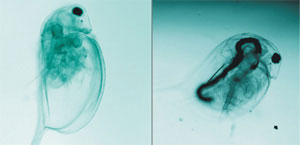| Posted: March 7, 2007 |
Lipid coating increases uptake of nanotubes |
|
(Nanowerk News) As the rapidly expanding nanotechnology industry churns out newer and more complex nanomaterials, many worry about the potential environmental impacts of these materials.
|
|
A new study published today on Environmental Science & Technology's (ES&T) Research ASAP website shows that when carbon nanotubes are made water-soluble with natural lipid layers, they are readily taken up and structurally modified by daphnids, or water fleas (Daphnia magna). The nanotubes are also toxic to the fleas at high concentrations ("In vivo Biomodification of Lipid-Coated Carbon Nanotubes by Daphnia magna").
|
 |
| The empty guts of starved daphnids (left) fill up with water-soluble carbon nanotubes (right). (Image: Stephen Klaine et al.)
|
|
A previous study in ES&T ("Natural Organic Matter Stabilizes Carbon Nanotubes in the Aqueous Phase") showed that increased solubility makes nanotubes persist longer in aqueous environments, but the researchers did not test their direct impact on living organisms.
|
|
Carbon nanotubes are known for their insolubility. However, treatments with various materials, like surfactants and certain natural polymers, make them more water-loving.
|
|
To investigate the potential toxicity of water-soluble single-walled carbon nanotubes, environmental toxicologist Stephen Klaine of Clemson University and his colleagues placed different concentrations of lipid-coated nanotubes in cups of water containing starved daphnids. The researchers were surprised to find that as they increased the concentration of the nanotubes, more of the fleas survived. Without nanotubes, 20% survived, whereas with 0.5 milligrams of nanotubes per liter (mg/L), about 90% survived. Beyond 0.5 mg/L, the fleas began to die and fall to the bottom of the cups. “It was good for a while,” says Klaine. “And then it became toxic.”
|
|
Klaine repeated the experiment with algae in the cups containing the nanotubes and water fleas. In the presence of algae, nearly 100% of the fleas survived at all concentrations of nanotubes up to 5 mg/L. The numbers fell to a little less than 80% at 10 mg/L. The results suggest that the toxicity of the tubes was from ingestion and that when algae were present, the daphnids ate more algae and fewer nanotubes. They also observed the daphnids under the microscope and found that their guts fill up with nanotubes within 45 minutes to an hour of exposing them to the material.
|
|
As the fleas gorged on the soluble nanotubes, the researchers also observed a dark precipitate accumulating at the bottom of the cups, just like the kind that forms when the uncoated, insoluble nanotubes are put in water. Klaine suspected that the daphnids were swallowing the tubes, stripping the lipid layer, using it for food, and spitting out the naked nanotubes, thus making them insoluble once again. The researchers confirmed that suspicion with a spectrophotometry technique that showed that the black precipitate did indeed have identical spectral properties to the original, unmodified nanotubes. Taken together, this meant that not only were daphnids feeding on these tubes but they were also “drastically modifying” them, says Klaine.
|
|
The study also illustrates the significance of evaluating the environmental impacts of both coated and uncoated nanomaterials, especially since they have different solubilities , says Klaine. “The implications are that [a soluble nanoparticle] is moving downstream,” he points out. This will affect organisms in the water even far away from the site of release of the nanoparticles. On the other hand, an insoluble nanoparticle “remains in the sediments. So, entirely different organisms get affected,” he says.
|
|
However, the study does not elucidate the mechanism by which these particles kill water fleas or how the daphnids use the lipid layer for food, he adds.
|
|
“This is a nice piece of meat,” says Ronald Turco, an environmental toxicologist at the Purdue Climate Change Research Center who studies the environmental impact of nanomaterials on microbes. The modification of the nanotubes by the Daphnia makes for “really interesting findings for the environmental world,” he adds. Until now, the few studies on ecotoxicity of nanoparticles have focused on the materials themselves. This study “shows that the coating matters,” says Turco. “We do have to be careful of what we put on the outside more than [what is] inside.”
|
|
However, this is not the final word on the environmental impact of such soluble nanomaterials, caution Klaine and Turco. It is only the beginning of evaluating their environmental effects. “This is going to lead us to doing similar work in other organisms,” says Klaine.
|
|
See our related Nanowerk Spotlight: "The challenge of designing nanomaterials with reduced toxicity".
|

